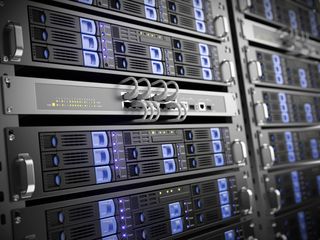The Microsoft Cloud Platform System unpacked
Microsoft debuts an Azure-consistent private cloud delivered in a box

Ever since Microsoft debuted its Azure public cloud service in 2008, enterprises and service providers have called for a version they could run themselves.
In response, the software giant has previously offered the Windows Azure Pack as a means of getting an Azure-like portal to navigate virtualised services and offer a private cloud within a company, or provided ‘fast track’ hardware packages as shortcuts for setting up a private cloud.
From 3 November, you’ll be able to buy the Microsoft Cloud Platform System (CPS) CEO Satya Nadella announced today, which is a standard full-size rack built by Dell that’s pre-populated with all the hardware and software you need to run a fully automated “Azure-compatible” cloud.
That includes two miles of plugged-in internal cabling, network switches (already configured by Microsoft), as well as hard drives and SSDs (already set up as Storage Spaces with 0.7PB of usable storage triple mirrored for workloads and dual striped for backups).
If one rack isn’t enough, users can put up to four in a ‘stamp’ and manage them all together, or put a stamp in each of their datacentres to achieve failover through Azure Site Recovery.
The idea is to deal with some of the main disadvantages of private cloud. For instance, the lack of cloud expertise within enterprises and the fact that no end user has the volume-buying clout of a cloud service like Azure or Amazon.
CPS buyers get the same Windows Server 2012 R2, System Center 2012 R2 and Windows Azure portal as other Microsoft customers, complete with all the extras like Data Protection Manager and ASR. “Nothing you need to run a cloud is an add-on,” says Vijay Tewari, the principle group programme manager for System Center, “if you need it, it’s there in CPS.”
Cloud Pro Newsletter
Stay up to date with the latest news and analysis from the world of cloud computing with our twice-weekly newsletter
What you get pre-configured are settings based on what Microsoft has learned by running Azure and Office 365 and its other cloud services. That includes Microsoft’s internal cloud service, Nebula, part of which is already running on CPS.
And you get it on standardised hardware that Microsoft knows inside and out, down to the firmware on the hard drives.
Not only will the price reflect “supply chain economics that take advantage of Azure,” according to Tewari, but also show what you can save by doing more in software.
“We’re really putting software-defined to the test. Can you provide the agility and resiliency you need at a different fundamental price point?”
Private cloud failings “We found a lot of people trying to do private cloud were failing,” Tewari tells Cloud Pro.
“Almost 80 per cent of private cloud projects today are failing. One problem is the expectation is that you say the magic word ‘cloud’ and it just happens.”
In truth, it’s more like nine months for a private cloud project, which Microsoft hopes CPS can cut down considerably to one month.
“This solution is a validated system architecture from top to bottom. From the bottom-most layer and exactly which disk we inject into storage, all the way up to the portal we expose to the customer.
“We believe the work that has gone into the design saves you six to seven months of design work, not just deployment,” Tewari adds.
Each CPS rack is assembled, remotely and automatically deployed and then load tested before it ships.
“We simulate a year's worth of damage to the system in one week,” boasts Tewari.
The cost of private cloud isn’t just how much you pay for the hardware.
“When we look at the cost of this solution, it's not just ‘did I pick the right hardware?’ but does it allow for people to administer it with the least workload?” asks principle program manager Spencer Shepler.
Tewari suggests that may be the hardest thing for users to get their heads’ around: “They’re so used to the daily feeding and care of their babies. They have to stop caring. Don't name your server!”
The set up for a CPS rack isn’t naming and custom integration, “it’s reams and reams of PowerShell automation,” he adds.
Automate everything Automation is key to running a CPS rack as a cloud rather than an efficient virtualisation system.
“Humans are the least predictable thing, so automate yourself out,” Tewari advises.
“You deploy this in a known boot state and keep the system in that state. Any time you touch the system, you do it through automation.”
That applies to the way the system is built: “All the infrastructure sits on virtual machines. All the compute is deployed as VMs, [and] the only thing that runs physically on the metal in CPS is the storage stack and you don’t have to touch the physical network infrastructure because all the isolation is achieved in software-defined networking,” Tewari says.
Even the management stack is virtualised, with System Centre Virtual Machine Manager and Orchestration Manager running in its own guest clusters and the Windows Azure Pack running behind a load balancer.
And the system is designed to be redundant for N+2 resiliency, says Shepler. “If you lose two components, that’s not going to take the whole thing down. You will still have compute and data availability.”
When hardware fails, you deal with it cloud-style. “We built a system that doesn’t require replacement as soon as it fails. We alert you on a weekly or monthly basis, the way it happens in large datacentres.
“And when you need hardware you have a supply chain sitting behind you that can replace it for you,” Tewari promises.
Microsoft will aggregate details on hardware failures, to see if there’s an underlying problem – and it can do that at cloud scale.
The CPS team did that during their 18 months of development, says Shepler, before asking Dell to check if the equipment failure rate Microsoft saw matched other systems with the same hardware.
“We can start to say ‘does this particular kind of disk fail more than that kind’ and root cause that.”
At your service The hardware is designed for fast servicing, from field-replaceable server units, to JBOD drawers that pull out without tools, to network cables that are long enough to move to the side so you can reach the power plugs behind them.
CPS is also designed to simplify the monthly patching that’s another disadvantage for private cloud.
“We provide a set of updates that we’ve validated on CPS and on Nebula that only then goes to the customer,” says Tewari.
“We provide it through a framework that orchestrates up from the firmware, the BIOS [and] the NIC BIOS, all the way up to the stack.
“When we apply a patch to the Hyper-V host, we drain it, patch it and rehydrate it all back when patching is complete and we do that for the entire stack in an orchestrated fashion.”
The same applies when using the private cloud. The CPS monitoring system includes backup, disaster recovery and day-to-day tools. “All the scripts you'd use for tasks like changing passwords across the whole cluster, bringing everything back after a system restore – it’s all there,” says Tewari.
“We worked with the engineering teams for products like SQL Server, Exchange, SharePoint and Lync and we provide automation to deploy their best practice in an orchestrated fashion.
“We give you the automation run books. If I want to deploy multi-tier SharePoint, the system spins that up with Desired State Configuration and orchestration.”
Microsoft is careful to call the Cloud Platform System Azure-compatible and it isn’t actually Azure in a box.
It’s not just subtle differences like getting the current version of the Azure Portal rather than the next version and a different agent for customising your VM workloads (both of those will become the same over time, Tewari predicts).
Unless you’re Microsoft, you don’t actually want Azure to run yourself. “The tools and processes that run Azure are designed for a very different scale and a very different skill set,” he points out.
“These are tailor made for the customer.”
What you get are the same pieces Microsoft uses to build Azure, pre-built into a private cloud you can run like a cloud. If a private Microsoft cloud is what your business needs, this is the simplest way so far to get it.
Mary is a freelance business technology journalist who has written for the likes of ITPro, CIO, ZDNet, TechRepublic, The New Stack, The Register, and many other online titles, as well as national publications like the Guardian and Financial Times. She has also held editor positions at AOL’s online technology channel, PC Plus, IT Expert, and Program Now. In her career spanning more than three decades, the Oxford University-educated journalist has seen and covered the development of the technology industry through many of its most significant stages.
Mary has experience in almost all areas of technology but specialises in all things Microsoft and has written two books on Windows 8. She also has extensive expertise in consumer hardware and cloud services - mobile phones to mainframes. Aside from reporting on the latest technology news and trends, and developing whitepapers for a range of industry clients, Mary also writes short technology mysteries and publishes them through Amazon.





